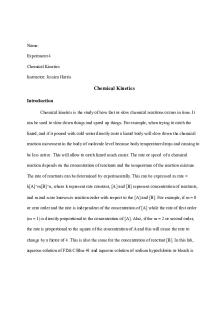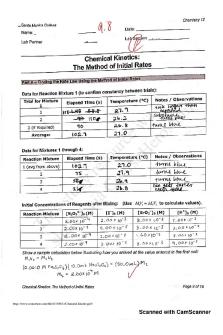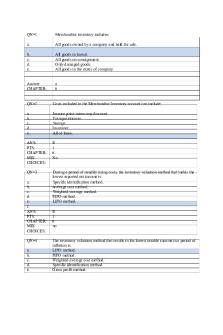UA Lab 5 Clinitek & Other tests Semi Automated Chemical Analysis PDF

| Title | UA Lab 5 Clinitek & Other tests Semi Automated Chemical Analysis |
|---|---|
| Author | Christina Williams |
| Course | Clinical Hematology, Coagulation, And Urinalysis Practicum |
| Institution | Saddleback College |
| Pages | 10 |
| File Size | 215.3 KB |
| File Type | |
| Total Downloads | 69 |
| Total Views | 119 |
Summary
lab exercise for semi automated routine urine chemistry...
Description
Saddleback College │MLT 235 │Clincial Urinalysis Lab
Urinalysis Laboratory Exercise 5│ Urine Chemical Analysis - Clinitek I.
Objective
1. Perform urine chemical analysis on Clinitek Status 2. The student will be able to perform quality control tests and determine the acceptability of test results. 3. The student will be able to perform the following physical and chemical examinations within ± 1 unit a. Color and Transparency (also called Clarity) b. Specific gravity (by TS meter and / or dipstick) c. Urine chemical concentrations of protein, glucose, ketones, bilirubin, blood, nitrite, urobilinogen, leukocyte esterase, and pH using Multistix reagent strip method d. Protein by sulfosalicylic acid – If supplies available e. Ketones by Acetest tablet method f. Bilirubin by Ictotest tablet method g. Reducing substances by Clinitest tablet method
II.
Materials 1. 2. 3. 4. 5. 6. 7. 8. 9.
Quality Control Urine Samples Urine Sample 1 –Your urine sample Urine Sample 2 –Instructor will provide sample Urine Dipsticks Clinitek Status Analyzer 3% sulfosalicylic acid Acetest tablets & product insert Ictotest tablets, absorbent pads & product insert Clinitest (Aims) tablets, reaction tubes & product insert
III.
Principles of Clinitek: Please refer to manual.
IV.
Procedure for testing patient samples – Clinitek 1. Each student will be perform four urine tests on the Clinitek: 2 QC, 1 2. Use the following controls: Multistix Level 1 Multistix Level 2 3. Touch the Strip Test on the main select menu. 4. Enter data requested by the prompts. Your initials, lot#s, expiration date. 5. Check expiration date on strip bottle 6. Remove one strip from bottle, tightly close the bottle. 7. Dip strip into the urine. 8. Remove quickly. 9. Hold the dipstick on its side and blot excess urine on a paper towel. 10.Press start on the analyzer 11.Results will automatically print. 12.Attach to your worksheets. 13.Record results.
Page 1 of 10
Saddleback College │MLT 235 │Clincial Urinalysis Lab
Urinalysis Laboratory Exercise 5│ Urine Chemical Analysis - Clinitek
V.
(1pt ) Clinitek Quality Control Level 1
QC 1
Analyte
Level 1 Analyte Range
Glucose
Negative
Bilirubin
Negative
Ketones
Negative
Specific Gravity
1000(+++) mg/dL
Bilirubin
Small(+) – Large(+++)
Ketones
15(+) - >160(Large) mg/dL
Specific Gravity Blood (Hemoglob in) pH
1.010 - >1.030
Protein
30(+) - >300(+++) mg/dL
Small(+) – Large(+++) 6.5-9.0
Urobilinoge 1.0 - >8.0 mg/dL n Nitrite Positive Leukocyte Esterase
Trace – Large(+++)
QC Evaluation: Circle: Pass / Fail
Page 3 of 10
Saddleback College │MLT 235 │Clincial Urinalysis Lab
Urinalysis Laboratory Exercise 5│ Urine Chemical Analysis - Clinitek
VII.
(2 pts) Urine Test Samples
Test Sample 2 Test Sample 1 Affix Clinitek Results Affix Clinitek Results
Page 4 of 10
Saddleback College │MLT 235 │Clincial Urinalysis Lab
Urinalysis Laboratory Exercise 5│ Urine Chemical Analysis - Clinitek VIII.
(2pts) Backup Tests
A. Ictotest Perform an Ictotest on each specimen showing a positive bilirubin on the dipstick using the following procedure. 1. Place a square of the absorbent test mat (provided by manufacturer) onto a white paper. 2. Place ten (10) drops of urine onto the center of the test mat. 3. Place one (1) Ictotest tablet on the moistened mat. 4. Carefully place one (1) drop of distilled/deionized water onto the top of the tablet. Wait five (5) seconds. Add a second drop of water to the table so that the water runs off the tablet onto the mat. 5. The presence of a blue or purple color on the mat indicates a positive test for bilirubin. (Slight pink or red color should be ignored.) 6. The test is subjectively graded as negative or trace to 4+. See manufacturer's product insert for example of positive results.
For positive control use KOVA Liqua-Trol Level I. Acceptable range is Positive: Pink-Purple. Package insert does not list purple. For negative control use KOVA Liqua-Trol Level II. Acceptable range is negative. Ictotest Reagent
Lot #____________ Exp.Date:________
Samp le ID
QC Lot #
Test Result
Acceptable Range
Evaluation
QC 1
Negative
QC – Pass / Fail
QC 2
Pink - Purple
QC – Pass / Fail
Test Sample 1 Test Sample 2
Page 5 of 10
Saddleback College │MLT 235 │Clincial Urinalysis Lab
Urinalysis Laboratory Exercise 5│ Urine Chemical Analysis - Clinitek B. (2 pts) Acetest Perform an Acetest on each specimen showing a positive ketone on the dipstick using the following procedure. 1. Place an Acetest table on a white paper. 2. Add one (1) drop of urine directly on the tablet. 3. At 30 seconds, compare the color of the tablet with the color chart provided by the manufacturer. 4. Report as negative, 1+ (for small amount), 2+ (for moderate amount), or 3+ (for large amount).
For positive control use KOVA Liqua-Trol Level I. Acceptable range is smalllarge, see package insert. For negative control use KOVA Liqua-Trol Level II. Acceptable range is negative.
Acetest Reagent
Lot #____________ Exp.Date:________
Acceptable Range
Evaluation
QC 1
Negative
QC – Pass / Fail
QC 2
Small - large
QC – Pass / Fail
Sam ple ID
QC Lot #
Test Result
Test Sample 1 Test Sample 2
Page 6 of 10
Saddleback College │MLT 235 │Clincial Urinalysis Lab
Urinalysis Laboratory Exercise 5│ Urine Chemical Analysis - Clinitek
C. (2pts) Clinitest Clinitest (5 drop method) Perform this procedure on urine specimens of all children under the age of 12 years to check for the reducing sugar, galactose. Because the dipstick is more sensitive and specific for glucose, this procedure is not used to quantify urine glucose. Ask course instructor about performing this procedure. The procedure is as follows:
1. Place five (5) drops of urine into a clean glass test tube. 2. With the same size dropper, add ten (10) drops of deionized water 3. Drop one (1) Clinitest table into the test tube. Watch while boiling reaction takes place. Do not shake tube during the reaction or for 15 seconds after the boiling has stopped. Remember to observe for the "pass through phenomenon."
4. At the end of the 15 second waiting period, shake test tube gently to mix contents 5. Compare the color of the liquid contents to the color chart provided for the five (5) drop method and report the percent (%) of the closest matching color.
6. For positive control use Multistix Control Level I. Acceptable range is 1/4 -1% or Positive: Purple-Green. Note: purple is not on your color chart, but this is acceptable for the control 7. For negative control use Multistix Control II. Acceptable range is negative. Clinitest Reagent
Lot #____________
Sam ple ID
QC Lot #
Test Result
Acceptable Range
Evaluation
QC 1
Negative
QC – Pass / Fail
QC 2
¼- 1 % or
QC – Pass / Fail
Exp.Date:________
Positive: -purple-green Test Sample 1 Test Sample 2 Page 7 of 10
Saddleback College │MLT 235 │Clincial Urinalysis Lab
Urinalysis Laboratory Exercise 5│ Urine Chemical Analysis - Clinitek
D. (2pts) Sulfasalic Acid 1. Perform sulfosalicylic acid test for protein 2. Into a small test tube, pour about ½ - 1 ml (10 - 20 drops) of the supernatant from centrifuged urine. 3. Add an equal amount of 3% sulfosalicylic acid solution to the urine. 4. Mix well by either “flicking” the urine or placing parafilm on the top of the test tube and inverting 2-3 times. 5. Grade for cloudiness as follows: Sulfasalic Acid
Negative – no cloudiness, Trace – Cloudiness is just perceptible against a black background 1+ – Cloudiness is distinct but not granular 2+ - Cloudiness is distinct and granular 3+ - Cloudiness is heavy with distinct clumping 4+ - Cloudiness is dense with large clumps that may solidify Sam ple ID
QC Lot #
QC 1
Lot #____________
Test Result
Acceptable Range
Negative
QC 2 ¼- 1 % or
Exp.Date:________
Evaluation
QC – Pass / Fail QC – Pass / Fail
Positive: -purplegreen Test Sample 1 Test Sample 2
Page 8 of 10
Saddleback College │MLT 235 │Clincial Urinalysis Lab
Urinalysis Laboratory Exercise 5│ Urine Chemical Analysis - Clinitek IX.
Lab Exercise 2 = ________________/ 24 pts Urine Test Exercises = ____________/12 pts & Lab Report/Competency = ___________/12pts
1. 10 pts: Clinitek Automation Report: See Clinitek Automation Report Instructions below: what I am looking for.
Include the following: Note: my answers are examples of
a. List the make and model- this is the name of the instrument and who makes the instrument. For example: LH750 (hematology model) made by Coulter. b. Principle of operation - what is reacting with what to give a result? For the Echo it is an antigen/antibody reaction which I wanted specifically detailed out. In hematology it is cell counting, how does the machine do it? For coagulation what is reacting with what to give the coagulation result? Read the procedure manual OR the manufacturers instrument guide to get this information. Simply stating that a hematology instrument counts cells is not enough. c. Number of samples - be specific, we want a NUMBER! This information can be found either in the procedure manual OR the manufacturers instrument guide. In some cases, this may pertain to the maximum amount of samples that can be tested at one time. For example, most blood culture instruments can hold up to 300 bottles at one time. d. Name of tests performed - be specific. "Routine blood bank tests" is not an answer, "ABO/D, antibody screen, antibody ID,..." is. e. Quality control - "Premade controls" is not acceptable. An example for Hematology might be - "Three levels of controls are run, high, low and normal. Specific ranges are given and if the controls fall out of these ranges...". Again, look at the procedure manual and specifically state the QC performed. f.
Calibration - "The machine runs calibration." is not acceptable. Look at the procedure manual or instrument guide to determine specifically how the calibration on the instrument is performed.
g.
Preventive maintenance - This is an essential function of your job. Does the tubing need to be cleaned? How? Does flushing have to be done? How frequently? With what? Why?
h.
Acceptable samples - "plasma samples" is not an acceptable answer. What type of plasma? EDTA? Heparin? How old can the sample be? Are hemolyzed, icteric or lipemic samples acceptable?
Page 9 of 10
Saddleback College │MLT 235 │Clincial Urinalysis Lab
Urinalysis Laboratory Exercise 5│ Urine Chemical Analysis - Clinitek i.
Limitations of the equipment - what specifically will cause erroneous results such as false positives, negatives, inaccurate cell counts or automated diffs, or inaccurate coag results. Be specific. Automation makes our lives easier but you must be knowledgeable about the limitations of the equipment to trouble shoot and problem solve erroneous results.
2. 3 pts: Create a training checklist and initial competency assessment form for
the Clinitek . See examples on blackboard. Following methods may be used to assess competency: Observation of a patient test Written exam Proficiency test sample testing Observation of maintenance Review of results.
Page 10 of 10...
Similar Free PDFs

Ua - nuttig
- 4 Pages

Priority lab tests - ATI
- 1 Pages

Semi
- 1 Pages

Ss-5 - other
- 5 Pages

Semi 4 - Semi 4
- 14 Pages

Lab Report Chemical Composition
- 3 Pages

Chemical Kinetics - lab report
- 4 Pages

Chemical Kinetic Lab Report
- 2 Pages

Chemical Bonding Lab
- 7 Pages

Chemical Kinetics lab
- 9 Pages

Unit 5 Chemical Bonding
- 6 Pages
Popular Institutions
- Tinajero National High School - Annex
- Politeknik Caltex Riau
- Yokohama City University
- SGT University
- University of Al-Qadisiyah
- Divine Word College of Vigan
- Techniek College Rotterdam
- Universidade de Santiago
- Universiti Teknologi MARA Cawangan Johor Kampus Pasir Gudang
- Poltekkes Kemenkes Yogyakarta
- Baguio City National High School
- Colegio san marcos
- preparatoria uno
- Centro de Bachillerato Tecnológico Industrial y de Servicios No. 107
- Dalian Maritime University
- Quang Trung Secondary School
- Colegio Tecnológico en Informática
- Corporación Regional de Educación Superior
- Grupo CEDVA
- Dar Al Uloom University
- Centro de Estudios Preuniversitarios de la Universidad Nacional de Ingeniería
- 上智大学
- Aakash International School, Nuna Majara
- San Felipe Neri Catholic School
- Kang Chiao International School - New Taipei City
- Misamis Occidental National High School
- Institución Educativa Escuela Normal Juan Ladrilleros
- Kolehiyo ng Pantukan
- Batanes State College
- Instituto Continental
- Sekolah Menengah Kejuruan Kesehatan Kaltara (Tarakan)
- Colegio de La Inmaculada Concepcion - Cebu




